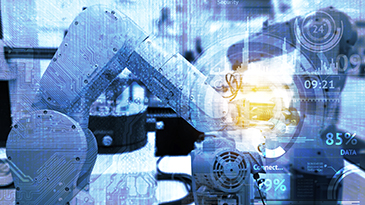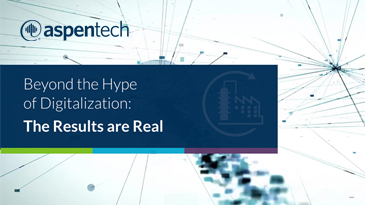If your fridge can tell you when you need milk, cheese or eggs before you realize it – potentially while you are at the grocery store – is that intelligence? I say yes. Your consumer appliance is giving you more than just data of what’s in the fridge, it’s telling you something you can act on.
So, what's the equivalent in a factory for an essential piece of equipment? Should that equipment automatically tell you how it's doing or alert you if it needs repair before you know it needs maintenance? This means you need more than just data: you need actionable information. This type of intelligence may soon become standard in new industrial equipment and delivered by the OEMs.
However, this type of intelligence is not natively part of today’s equipment (new or old) in existing industrial facilities. Therefore, the opportunity is to figure out how to introduce this intelligence to deliver actionable information about equipment and provide businesses true value from the data collected. Just having the data and ability to compute something on the edge does not automatically imply intelligence. True intelligence delivered on the edge implies the data collected and the calculated information have a valuable business outcome.
Where Does the Intelligence Lie?
When referring to edge, does edge computing mean the same as an intelligent edge? I say no! Current media focuses mainly on the computing capabilities of modern edge technology. These capabilities are more like specifications that are available to anyone who wants to take advantage of it. The amount of memory or CPU available and a calculation toolkit does not constitute intelligence. The ability to deliver actionable insights by leveraging an edge device’s compute power drives edge intelligence.
I believe when you truly leverage modern edge computing capabilities to drive business outcomes by creating valuable intellectual property (IP), you achieve intelligence on the edge. Extracting the IP of high value applications (the models or algorithms) and delivering that on the edge is true edge intelligence because you are using this IP to deliver value! The challenge is how to develop, package and deliver these computationally heavy models or algorithms to today’s edge. It was only recently that the big topic was how to move heavy compute applications like machine learning to the cloud to leverage the flexibility and on-demand access to high CPU power.
Now we’ve turned that position around and want to push online computing back to smaller, less CPU-intensive edge devices. I feel the best approach has to be a combination of both cloud and edge. We still want to use the cloud to train and develop the algorithms and the edge to deliver it. Why? Because it can be expensive to put these models or algorithms online and the cloud sometimes has an undesirable latency in receiving and transmitting data or calculated results. This latency can become an issue for industrial equipment health or even equipment users’ safety.
The Goal: Real-time Intelligence Where It Delivers Value
At AspenTech our goal is to leverage today's edge computing technology in an optimal and scalable way to deliver our high-valued IP in an intelligent edge solution. This includes leveraging the edge to provide real-time connectivity to sensors, devices and data sources. It also encompasses ensuring the integrity and quality of this data while it’s delivered to a cloud or on-premise environment, where we want to leverage the compute power to analyze the data with our applications and then deliver the IP (models or algorithms) back to the edge where we put it online to deliver value. This will be AspenTech’s intelligence at the edge that our customers can use to drive critical business outcomes.
Learn more in the upcoming webinar “The Journey to the Smart Plant: Make IIoT a Profitable Reality.”
So, what's the equivalent in a factory for an essential piece of equipment? Should that equipment automatically tell you how it's doing or alert you if it needs repair before you know it needs maintenance? This means you need more than just data: you need actionable information. This type of intelligence may soon become standard in new industrial equipment and delivered by the OEMs.
However, this type of intelligence is not natively part of today’s equipment (new or old) in existing industrial facilities. Therefore, the opportunity is to figure out how to introduce this intelligence to deliver actionable information about equipment and provide businesses true value from the data collected. Just having the data and ability to compute something on the edge does not automatically imply intelligence. True intelligence delivered on the edge implies the data collected and the calculated information have a valuable business outcome.
Where Does the Intelligence Lie?
When referring to edge, does edge computing mean the same as an intelligent edge? I say no! Current media focuses mainly on the computing capabilities of modern edge technology. These capabilities are more like specifications that are available to anyone who wants to take advantage of it. The amount of memory or CPU available and a calculation toolkit does not constitute intelligence. The ability to deliver actionable insights by leveraging an edge device’s compute power drives edge intelligence.
I believe when you truly leverage modern edge computing capabilities to drive business outcomes by creating valuable intellectual property (IP), you achieve intelligence on the edge. Extracting the IP of high value applications (the models or algorithms) and delivering that on the edge is true edge intelligence because you are using this IP to deliver value! The challenge is how to develop, package and deliver these computationally heavy models or algorithms to today’s edge. It was only recently that the big topic was how to move heavy compute applications like machine learning to the cloud to leverage the flexibility and on-demand access to high CPU power.
Now we’ve turned that position around and want to push online computing back to smaller, less CPU-intensive edge devices. I feel the best approach has to be a combination of both cloud and edge. We still want to use the cloud to train and develop the algorithms and the edge to deliver it. Why? Because it can be expensive to put these models or algorithms online and the cloud sometimes has an undesirable latency in receiving and transmitting data or calculated results. This latency can become an issue for industrial equipment health or even equipment users’ safety.
The Goal: Real-time Intelligence Where It Delivers Value
At AspenTech our goal is to leverage today's edge computing technology in an optimal and scalable way to deliver our high-valued IP in an intelligent edge solution. This includes leveraging the edge to provide real-time connectivity to sensors, devices and data sources. It also encompasses ensuring the integrity and quality of this data while it’s delivered to a cloud or on-premise environment, where we want to leverage the compute power to analyze the data with our applications and then deliver the IP (models or algorithms) back to the edge where we put it online to deliver value. This will be AspenTech’s intelligence at the edge that our customers can use to drive critical business outcomes.
Learn more in the upcoming webinar “The Journey to the Smart Plant: Make IIoT a Profitable Reality.”





Leave A Comment